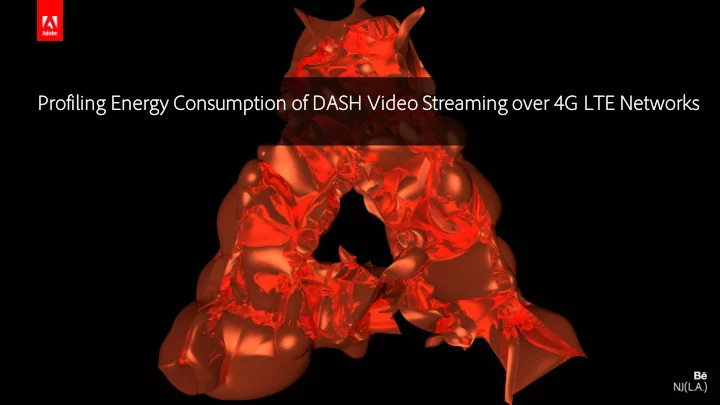

Pr Profiling Energy Consumption of DASH Video St Streaming over 4G 4G LTE Networks
Pr Profiling Energy Consumption of DASH Video St Streaming ov over 4G 4G LTE Ne Networks Jingyu Zhang 12 , Gan Fang 1 , Chunyi Peng 1 , Minyi Guo 2 , Sheng Wei 3 , Vi Swaminathan 3 Vishy Sw 1 The Ohio State University, USA 2 Shanghai Jiaotong University, China 3 Adobe Research, Adobe
Video Consumption on Mobile Devices … > 80% traffic by 2019 3
Video Streaming over 4G LTE Networks § Battery limit § 4G speed: >> 3G § Avg: 4~12 Mbps § Supports 3-5 hrs online video playing § Peak: 50Mbps § HD-video streaming 4
DASH: Dynamic Adaptive Streaming over HTTP § Resolution, segment length, buffer size Video CDN Qlty#1 HTTP request (Qlty#1) Qlty#2 Qlty#3 Video segment (Qlty#1) Qlty#4 5
Measurement Methodology § Open source streaming testbed Video Server § Server: Jetty § Player: Dash.js Video § Segmenting: MP4Box Segments § 4G LTE networks: T-Mobile and AT&T § Power monitor: Monsoon § Sample video: timer 6
Coarse-Grained Profiling § Online vs Offline (no network activities) § Background power (basic: screen, CPU, memory etc) 7
Testing Settings § Video Quality (Resolution) § 360p, 720p, 1080p § Segment Length § 2sec, 3sec, 4sec § Buffer Size § 30sec, 45sec, 60sec 8
Profile Resolution Segment Length Buffer Size 9
Video Resolution § Settings § Resolutions: 360p, 720p, 1080p § Segment length: 2s, 4s § higher res consumes more power § 360p: 331mW § 1080p: 619mW (187%) 10
Segment Length § Settings § Resolutions: 720p § Segment length: 2s, 3s, 4s § Larger segment length consumes less power § 2s: 521mw § 4s: 361mw (69.3%) 11
Buffer Size § Settings § Resolutions: 720p § Buffer: 30s, 45s, 60s § Larger buffer size consumes less power § 30s: 521mw § 60s: 422mw (81%) 12
Signal strength?
LTE Signal Strength (Speed) § Settings § Resolutions: 720p § Strong: 8-20Mbps § Weak: 3-3.8Mbps § Faster LTE speeds consumes less power. 14
Analysis and potential savings RRC (radio resource allocation)
RRC connection UE sends a RRC connection 1. request to eNodeB eNodeB responds UE with a RRC 2. connection message Finally the UE proceeds to 3. complete the procedure by send a RRC Connection Complete message 16
RRC State Transition over 4G LTE § RRC: Radio Resource Control § States: Idle (low power) and connected (high power) § Procedures: promotion and demotion 17
RRC Tail: No transmission but at high power 18
RRC tails in power traces Tail Tail Tail 19
Potential Saving § Larger segment length § Segment Length: 2s Segment Length: 4s: Saving: 30.7% (97.8J in the example) § Larger buffers § Buffer Size: 30s Buffer Size: 60s Saving: 19% 20
Summary § Profiled impact factors of video streaming network energy consumption § resolution § segment length § buffer size § Network condition § RRC tail: energy wastes § Consistent with prior findings § 30%+ potential saving (theoretically) § Future work: energy-efficient network-aware video streaming 21
Questions ?
Recommend
More recommend